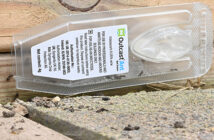It might not have been what Mitie clients in the North West were expecting to hear but, Peter Trotman, managing director of Mitie’s pest control business, made it abundantly clear that, by the end of 2014, the technique of permanent baiting will no longer be used at Mitie protected premises.
Peter was speaking at the National Museum of Football in Manchester last week at the second of two special client seminars on the theme of Knowing the pest risk – the first was held at London Zoo earlier this year. His presentation addressed the regulatory changes that are currently impacting the use of second-generation anticoagulant rodenticides (SGARs). As media partner Pest was pleased to attend.
| “Regulation drives change and our ability to manage your risk,” he said. He went on to explain how SGARs are cropping up in predatory bird species like barn owls and red kites. The principle reason for this is the long term use of toxic rodenticide baits in perimeter boxes. These baits are being taken by non-target rodents, such as field mice, which are then caught by predatory birds.
The pest control industry is currently developing a stewardship scheme for second-generation anticoagulant rodenticide (SGARs) but in advance of the scheme Mitie has already taken a lead. By the end of this year the 200,000 or so premises Mitie protects will no longer employ permanent baiting with toxic bait. “All perimeter bait boxes will be converted to break back traps and boxes that can’t take traps will be replaced with boxes that can,” explained Peter. Because each bait box will only kill one rodent this change will also alter the way boxes are deployed. He said that clusters of boxes will be used in high risk areas. “The continued protection of customers’ premises will require the upskilling of staff in detection, proofing and hygiene. There will also need to be greater involvement of clients’ staff – pest control will no longer be exclusively the pest control contractor’s responsibility,” he said. National training manager for Mitie, Grahame Turner, looked at how pests can be spread by human movement and trade, highlighting the potential threats to the UK from introduced species including the edible dormouse, which seems to be enjoying a surge in numbers. In the same premises, the company had trapped 1729 in 2013, up from 445 the previous year. His talk also covered mosquitoes and West Nile virus, tropical ants, herring gulls and false widow spiders. Later, Grahame also outlined the various means available to manage bird problems. Mitie sales director Danny Ashton reprised his presentation from the London event on the resurgent bed bug problem. In particular he outlined how Mitie has developed an integrated solution – an approach which the company has so much confidence in that they even offer a guarantee! Paul Butt from Natural England gave a re-run of his presentation on the use and abuse of pesticides. Pointing out that there was a reluctance to change in many pest control businesses he applauded Mitie for taking the lead in stopping permanent perimeter baiting. “We need to retain the option of perimeter use of rodenticides but only when it is needed,” he said. |
|
|
|
In a change from the first seminar two additional speakers addressed the audience. Tim Howell managing director of Mitie’s landscapes business widened the event to include plant pests and he pointed out that his people also have to deal with weeds and diseases! A lot of biological controls are employed. As pest controllers know there is a link between landscape and pest control with poorly designed landscaping simply providing harbourage for rodent pest. Tim pointed out that whilst bare flagstones might deter pests they don’t look good so there has to be a compromise. Finally, and appropriately, for the National Museum of Football, diehard Manchester United fan Mike Taylor talked about the synergies between pest control and waste management. Mike is managing director of Mitie’s waste management business. He drew some parallels between what has happened in the waste industry and what’s happening now in pest control. “When the first waste legislation came in there was very little sanction on those who ignored it, so most people did,” he said. “But, once the landfill tax arrived it focussed people’s minds. Now, more and more companies are seeing waste as a resource. The legislation is leading to cultural change and he suggested that this process will be repeated in pest control.” |
||





